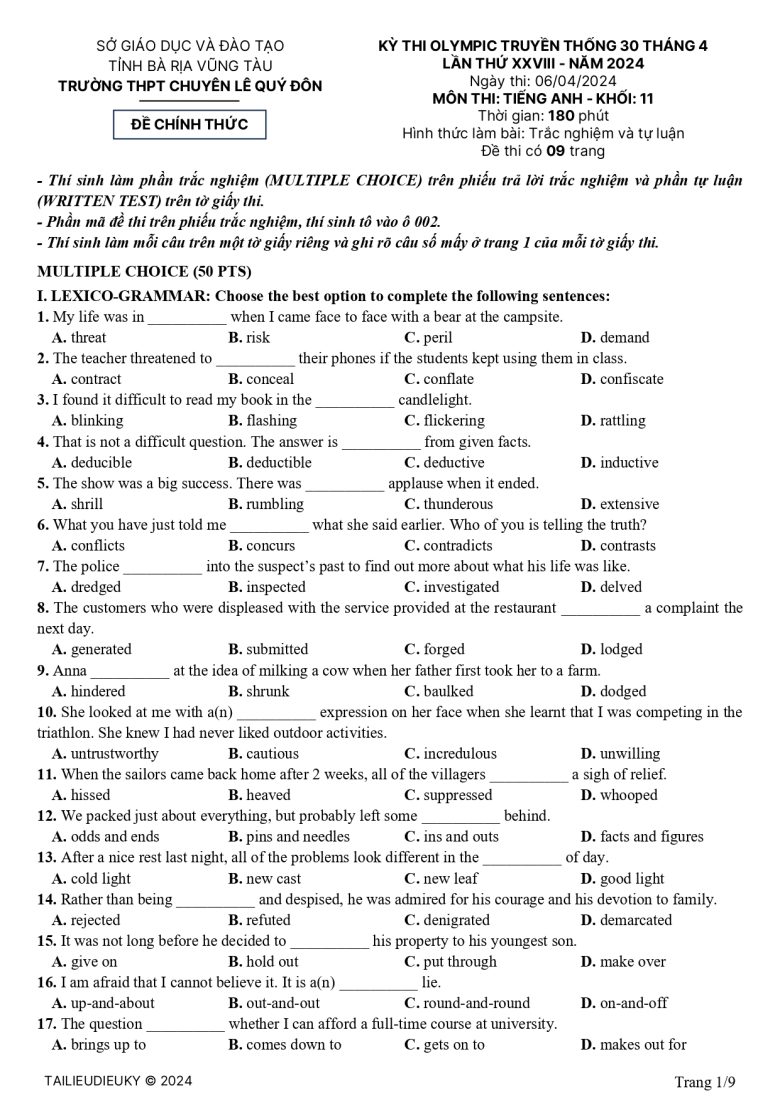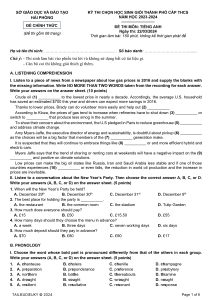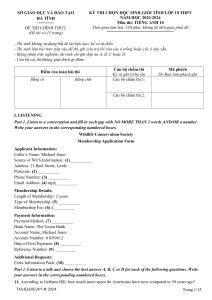Mời quý thầy cô và các em học sinh tham khảo Đề thi Olympic 30/4 môn Tiếng Anh 11 lần thứ 28 năm 2024 kèm theo đáp án và hướng dẫn chấm chính thức. Kỳ thi Olympic truyền thống 30 tháng 4 năm nay diễn ra từ ngày 5 đến 7/4 tại Trường THPT chuyên Lê Quý Đôn, tỉnh Bà Rịa - Vũng Tàu với sự tham gia của 80 đơn vị là các Trường trung học phổ thông thuộc khu vực phía Nam, miền Trung và Tây nguyên.
Đề thi Olympic 30/4 Tiếng Anh khối 11 năm nay gồm 2 phần Trắc nghiệm (Multiple choice) có 50 câu tương ứng 50 điểm. Phần tự luận (Written Test) - 100 điểm có 60 câu hỏi. Tổng điểm toàn bài là 150, thí sinh có 180 phút đề hoàn thành bài thi. Các em học sinh có thể tham khảo đầy đủ nội dung đề thi tại website Tài liệu diệu kỳ để rèn luyện và chuẩn bị cho Kỳ thi vào năm 2025.
Kết quả chính thức Kỳ thi lần thứ XXVIII của tất cả các đoàn dự thi cũng đã được Ban tổ chức công bố. Quý độc giả có thể tham khảo chi tiết TẠI ĐÂY.
Kỳ thi Olympic Truyền thống 30 tháng 4 là một sân chơi trí tuệ diễn ra hàng năm dành cho học sinh chuyên từ các lớp 10 và 11, nhằm chuẩn bị cho đội tuyển tham gia kỳ thi Học sinh Giỏi Quốc gia. Đây cũng là cơ hội để tạo điều kiện giao lưu và trao đổi kinh nghiệm giữa các giáo viên từ các trường chuyên khác nhau. Cuộc thi được tổ chức lần đầu vào năm 1995 bởi Trường THPT Chuyên Lê Hồng Phong, TP. Hồ Chí Minh và đến nay đã thu hút sự tham gia của nhiều trường THPT từ khu vực phía Nam, miền Trung và Tây Nguyên.
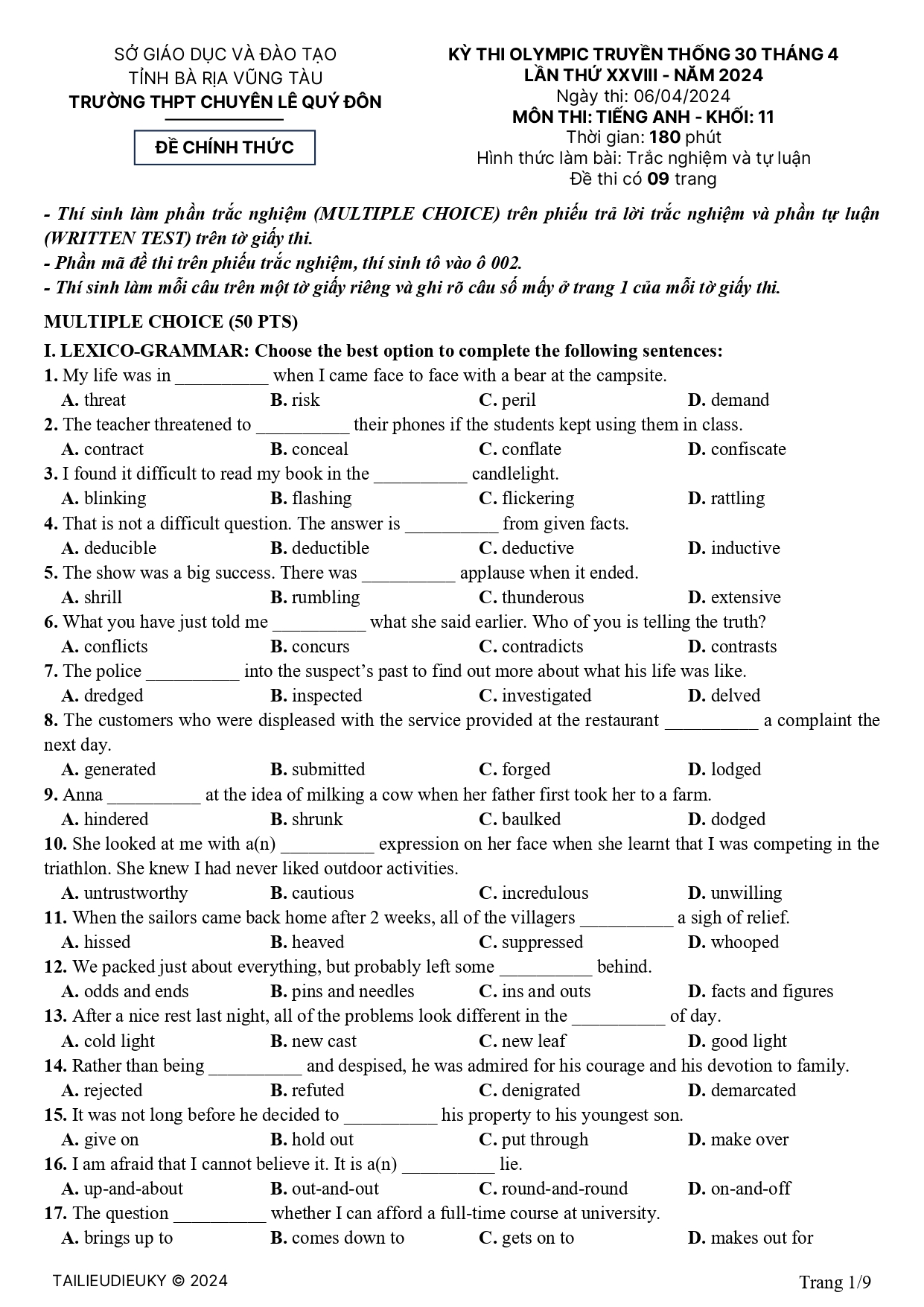
Đề thi Olympic 30 tháng 4 môn Tiếng Anh 11 lần thứ 28 năm 2024 - Trang 1/9
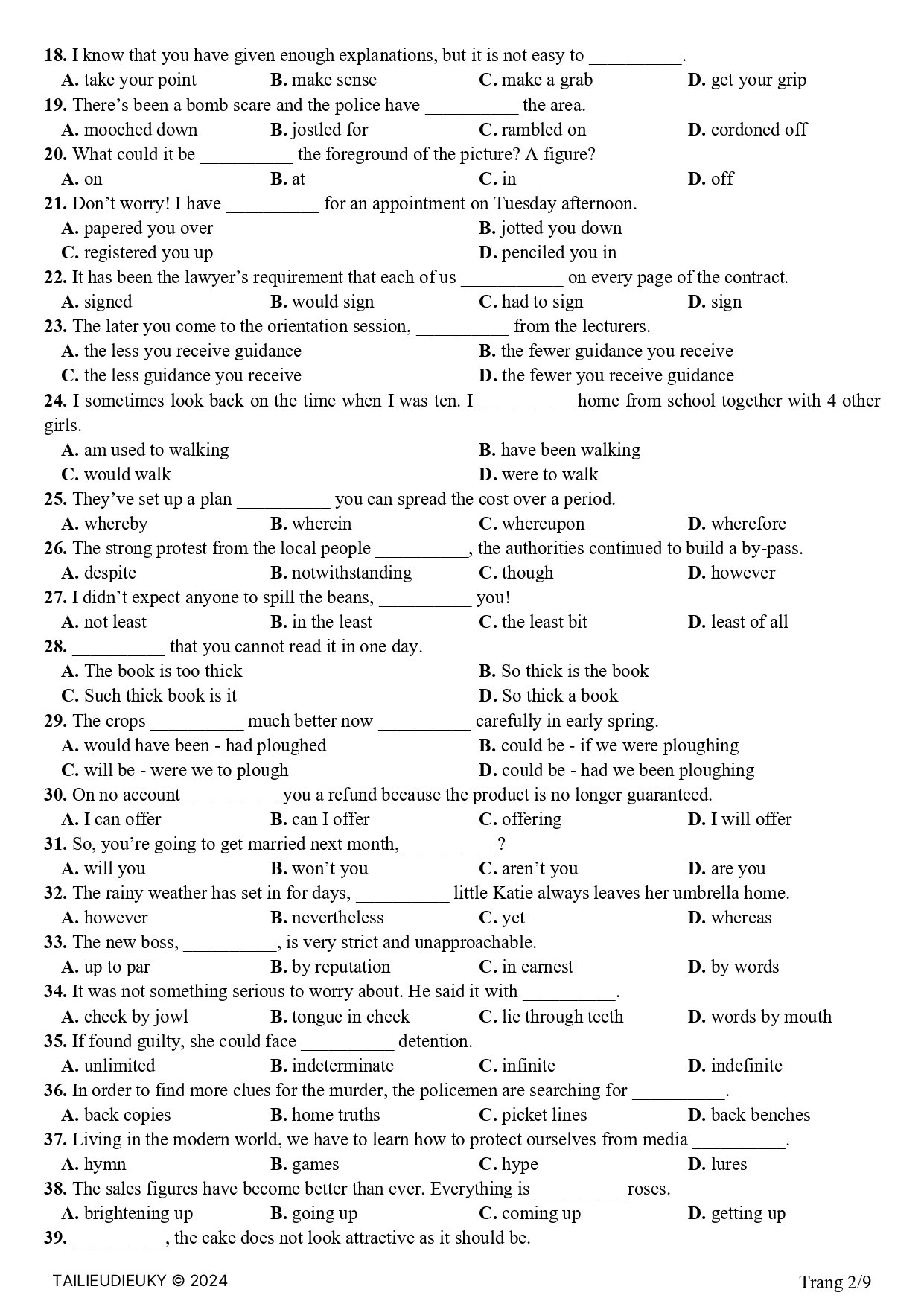
Đề thi Olympic 30 tháng 4 môn Tiếng Anh 11 lần thứ 28 năm 2024 - Trang 2/9
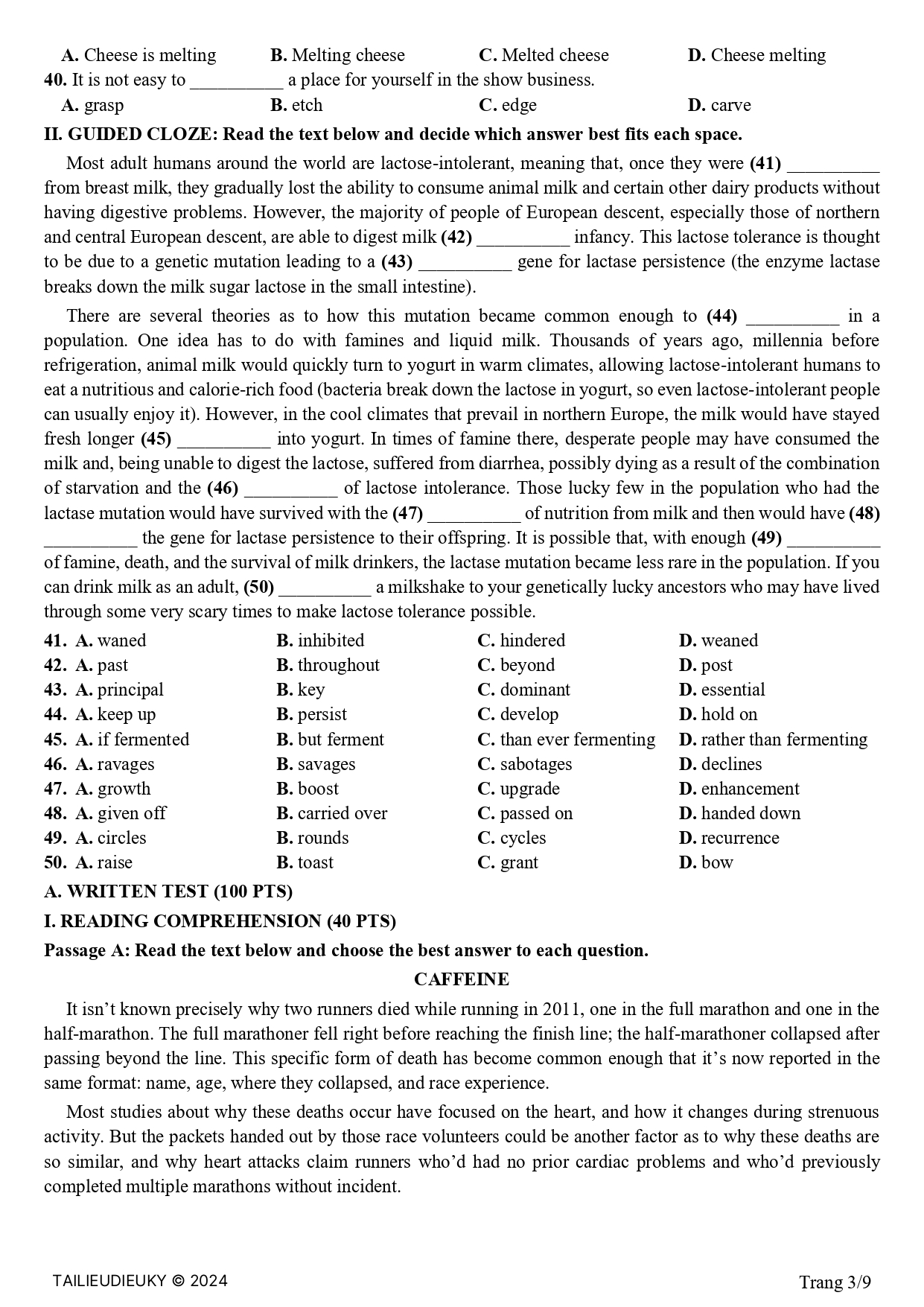
Đề thi Olympic 30 tháng 4 môn Tiếng Anh 11 lần thứ 28 năm 2024 - Trang 3/9
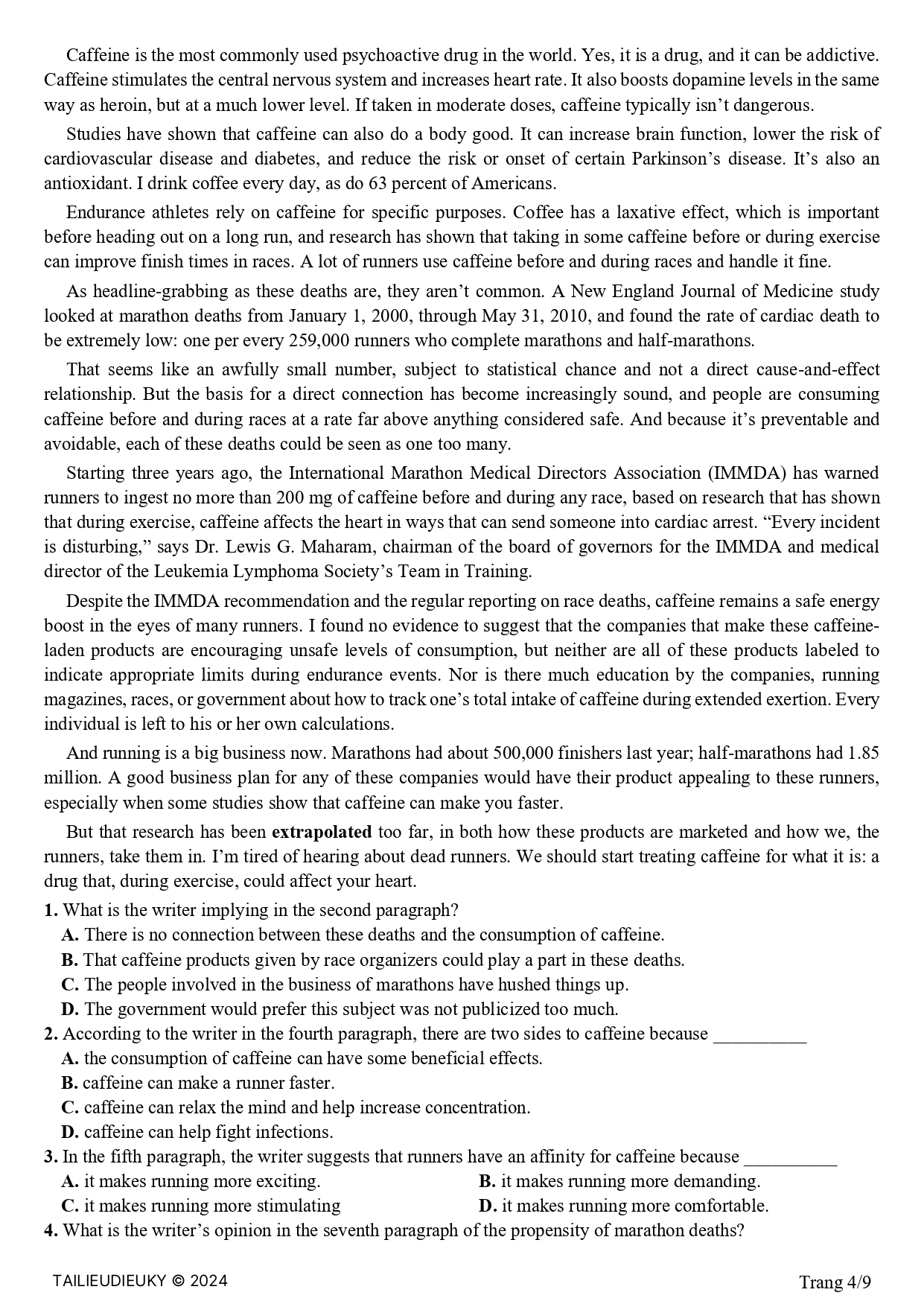
Đề thi Olympic 30 tháng 4 môn Tiếng Anh 11 lần thứ 28 năm 2024 - Trang 4/9
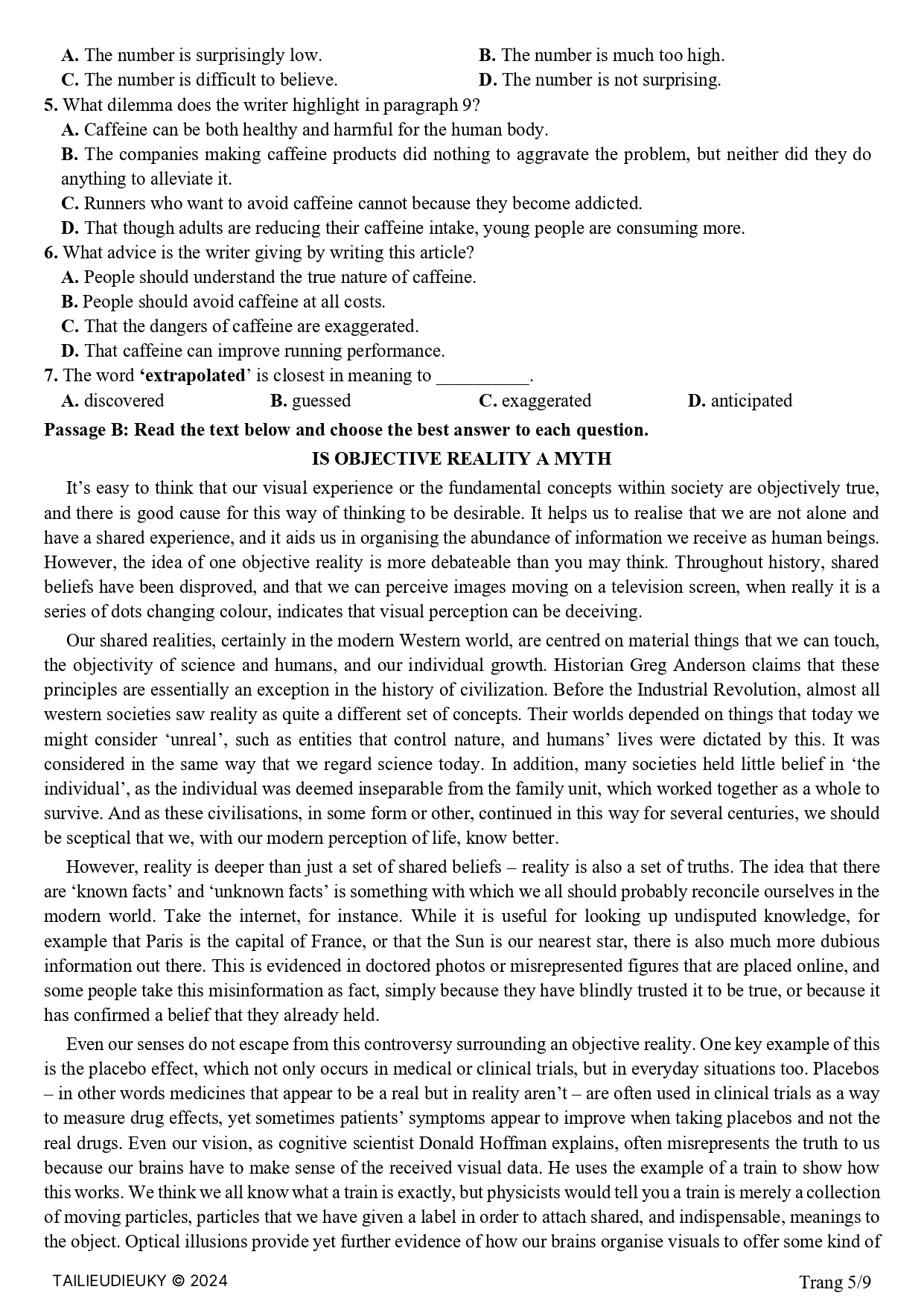
Đề thi Olympic 30 tháng 4 môn Tiếng Anh 11 lần thứ 28 năm 2024 - Trang 5/9
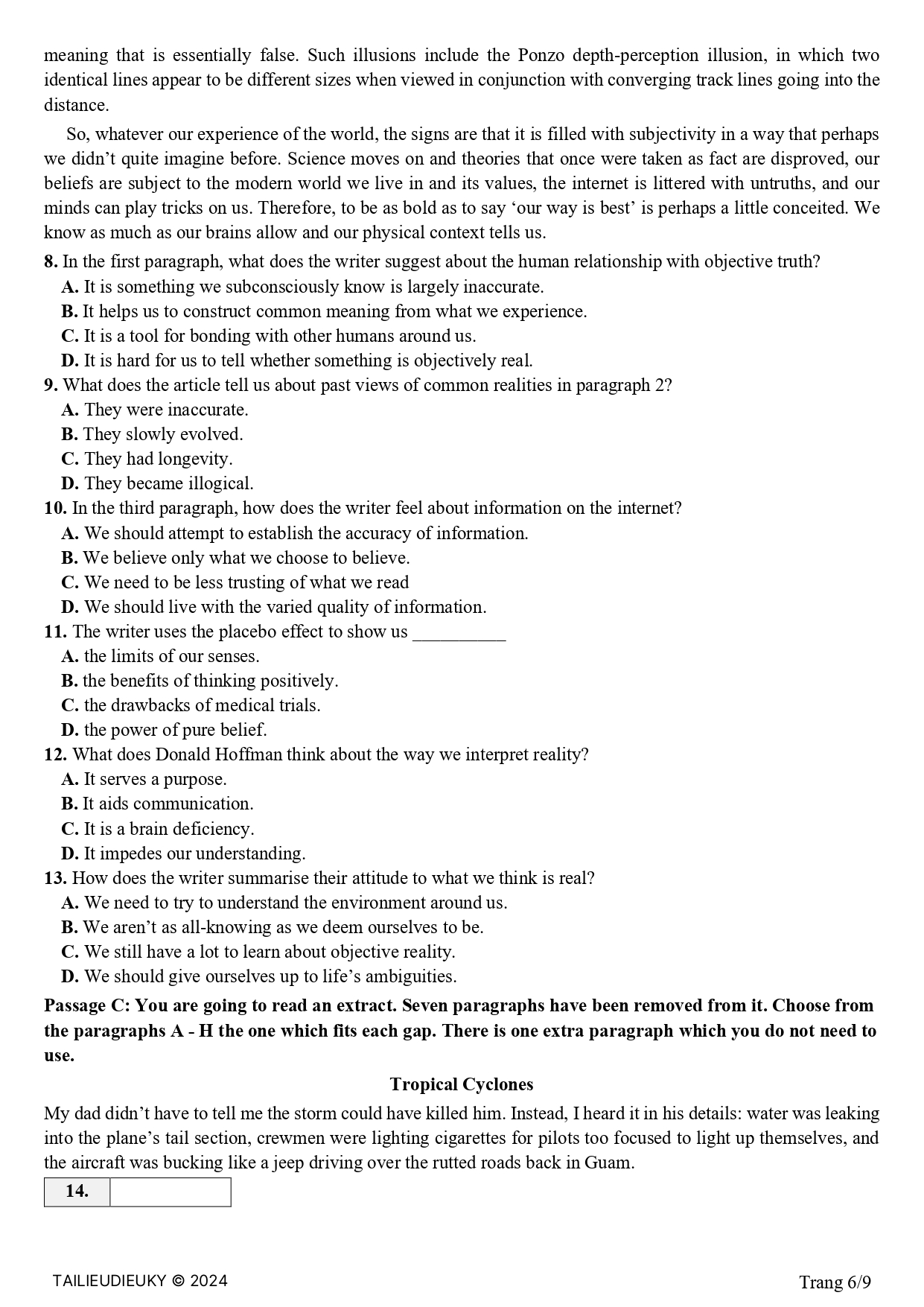
Đề thi Olympic 30 tháng 4 môn Tiếng Anh 11 lần thứ 28 năm 2024 - Trang 6/9
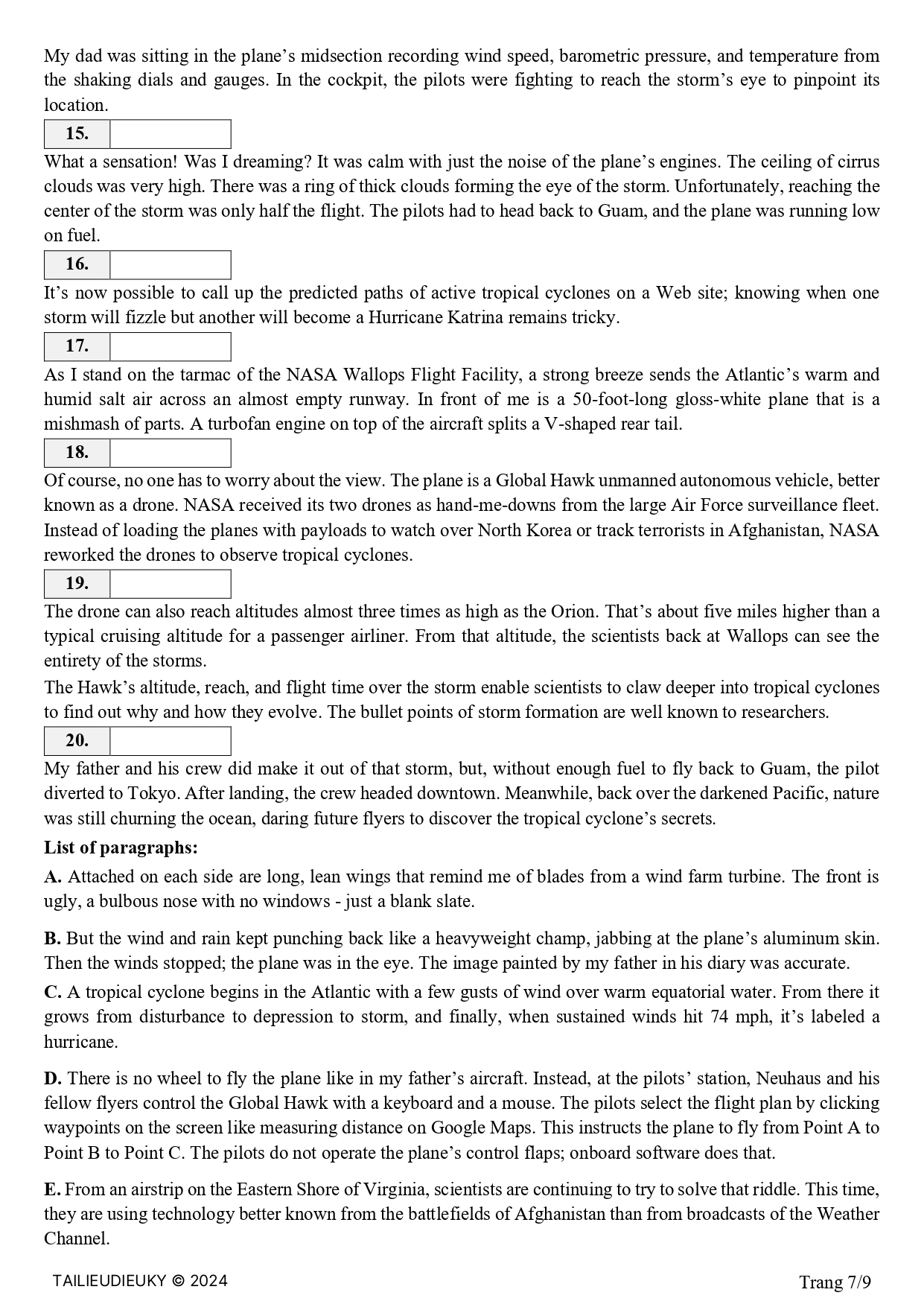
Đề thi Olympic 30 tháng 4 môn Tiếng Anh 11 lần thứ 28 năm 2024 - Trang 7/9
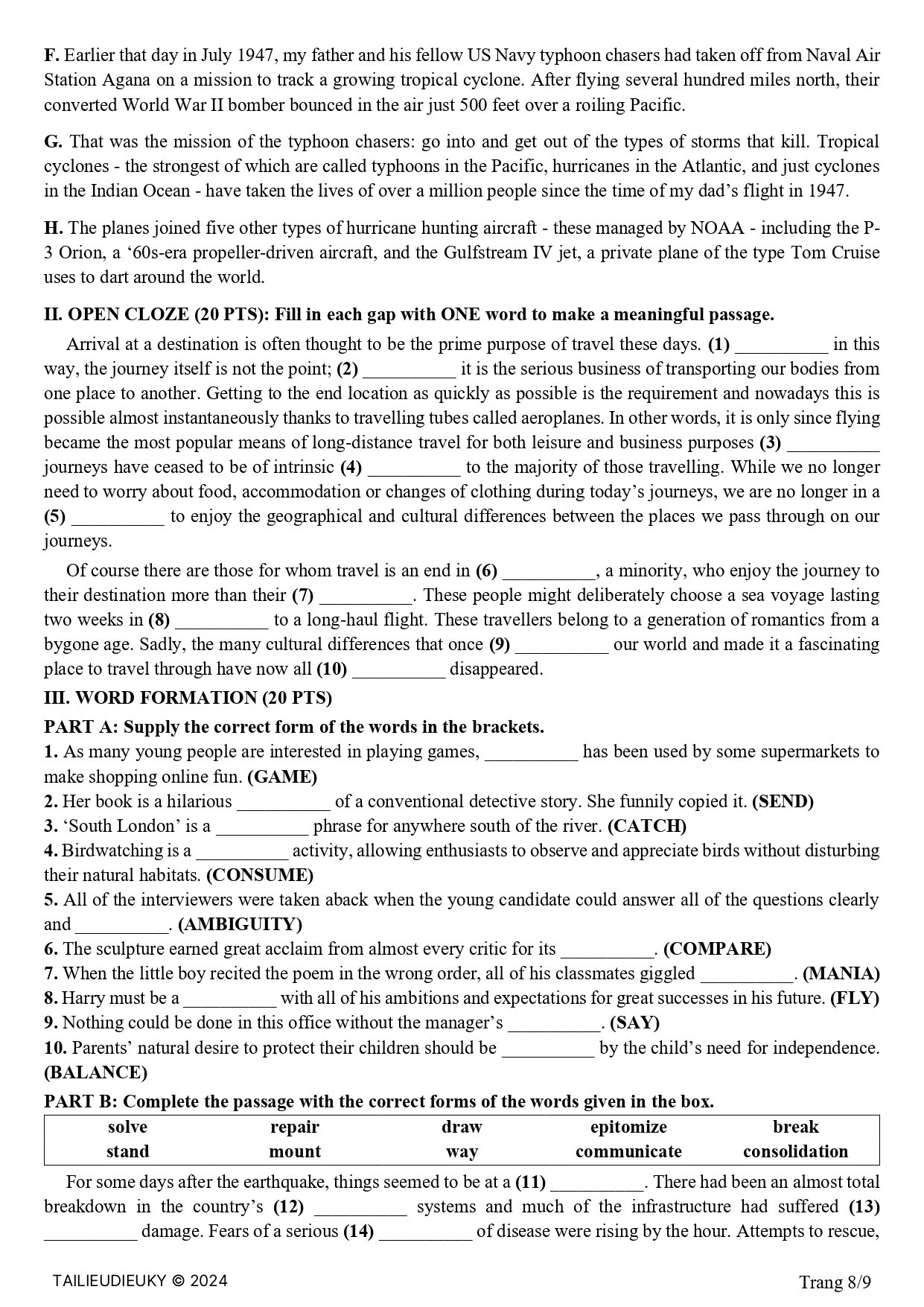
Đề thi Olympic 30 tháng 4 môn Tiếng Anh 11 lần thứ XXVII năm 2024 - Trang 8/9
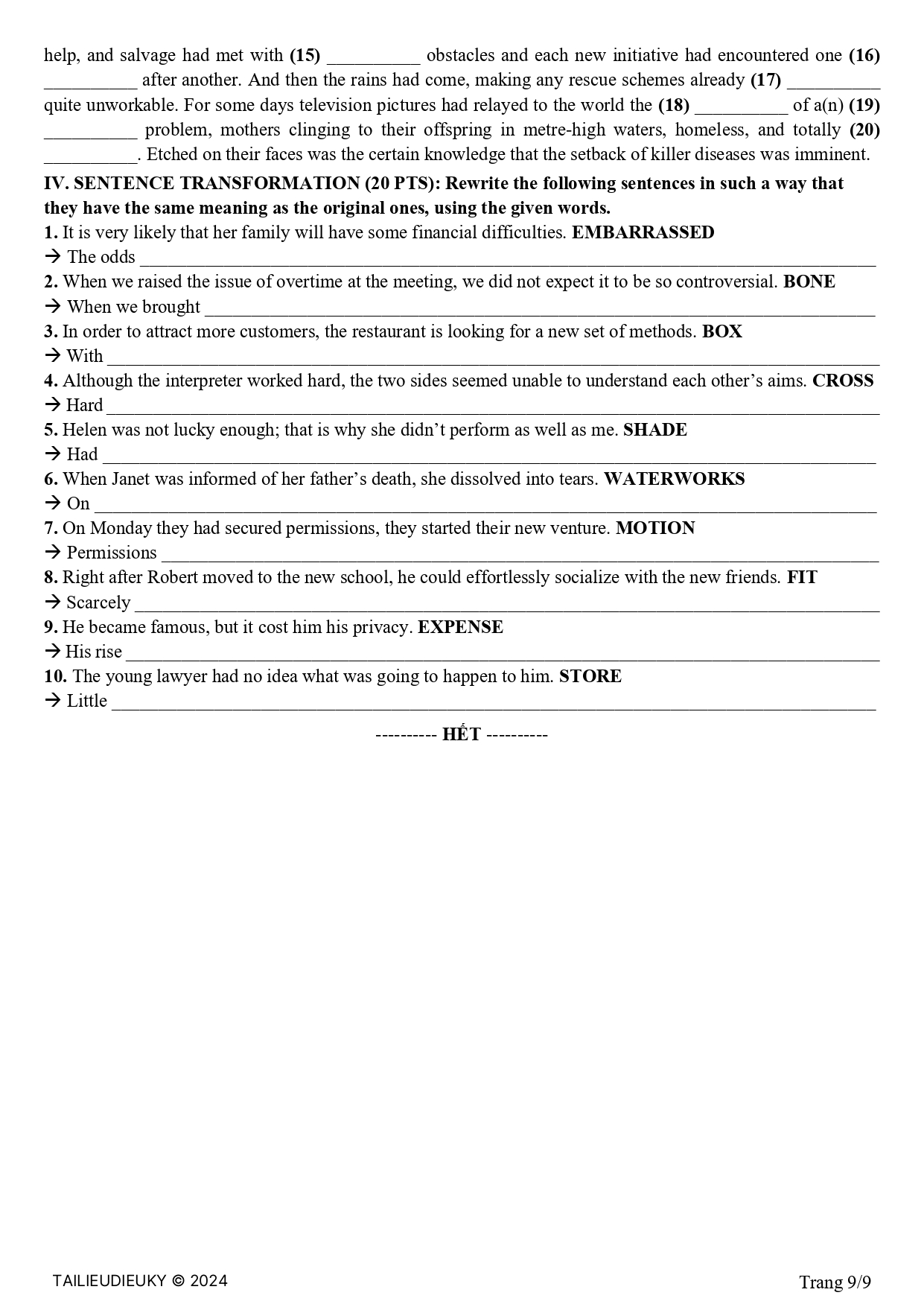
Đề thi Olympic 30 tháng 4 môn Tiếng Anh 11 lần thứ 28 năm 2024 - Trang 9/9
SỞ GIÁO DỤC VÀ ĐÀO TẠO
TỈNH BÀ RỊA VŨNG TÀU
TRƯỜNG THPT CHUYÊN LÊ QUÝ ĐÔN
KỲ THI OLYMPIC TRUYỀN THỐNG 30 THÁNG 4
LẦN THỨ XXVIII - NĂM 2024
Ngày thi: 06/04/2024
MÔN THI: TIẾNG ANH - KHỐI: 11
Thời gian: 180 phút
Hình thức làm bài: Trắc nghiệm và tự luận
Đề thi có 09 trang
- Thí sinh làm phần trắc nghiệm (MULTIPLE CHOICE) trên phiếu trả lời trắc nghiệm và phần tự luận (WRITTEN TEST) trên tờ giấy thi.
- Phần mã đề thi trên phiếu trắc nghiệm, thí sinh tô vào ô 002.
- Thí sinh làm mỗi câu trên một tờ giấy riêng và ghi rõ câu số mấy ở trang 1 của mỗi tờ giấy thi.
MULTIPLE CHOICE (50 PTS)
I. LEXICO-GRAMMAR: Choose the best option to complete the following sentences:
1. My life was in __________ when I came face to face with a bear at the campsite.
A. threat B. risk C. peril D. demand
2. The teacher threatened to __________ their phones if the students kept using them in class.
A. contract B. conceal C. conflate D. confiscate
3. I found it difficult to read my book in the __________ candlelight.
A. blinking B. flashing C. flickering D. rattling
4. That is not a difficult question. The answer is __________ from given facts.
A. deducible B. deductible C. deductive D. inductive
5. The show was a big success. There was __________ applause when it ended.
A. shrill B. rumbling C. thunderous D. extensive
6. What you have just told me __________ what she said earlier. Who of you is telling the truth?
A. conflicts B. concurs C. contradicts D. contrasts
7. The police __________ into the suspect’s past to find out more about what his life was like.
A. dredged B. inspected C. investigated D. delved
8. The customers who were displeased with the service provided at the restaurant __________ a complaint the next day.
A. generated B. submitted C. forged D. lodged
9. Anna __________ at the idea of milking a cow when her father first took her to a farm.
A. hindered B. shrunk C. baulked D. dodged
10. She looked at me with a(n) __________ expression on her face when she learnt that I was competing in the triathlon. She knew I had never liked outdoor activities.
A. untrustworthy B. cautious C. incredulous D. unwilling
11. When the sailors came back home after 2 weeks, all of the villagers __________ a sigh of relief.
A. hissed B. heaved C. suppressed D. whooped
12. We packed just about everything, but probably left some __________ behind.
A. odds and ends B. pins and needles C. ins and outs D. facts and figures
13. After a nice rest last night, all of the problems look different in the __________ of day.
A. cold light B. new cast C. new leaf D. good light
14. Rather than being __________ and despised, he was admired for his courage and his devotion to family.
A. rejected B. refuted C. denigrated D. demarcated
15. It was not long before he decided to __________ his property to his youngest son.
A. give on B. hold out C. put through D. make over
16. I am afraid that I cannot believe it. It is a(n) __________ lie.
A. up-and-about B. out-and-out C. round-and-round D. on-and-off
17. The question __________ whether I can afford a full-time course at university.
A. brings up to B. comes down to C. gets on to D. makes out for
18. I know that you have given enough explanations, but it is not easy to __________.
A. take your point B. make sense C. make a grab D. get your grip
19. There’s been a bomb scare and the police have __________ the area.
A. mooched down B. jostled for C. rambled on D. cordoned off
20. What could it be __________ the foreground of the picture? A figure?
A. on B. at C. in D. off
21. Don’t worry! I have __________ for an appointment on Tuesday afternoon.
A. papered you over B. jotted you down
C. registered you up D. penciled you in
22. It has been the lawyer’s requirement that each of us ___________ on every page of the contract.
A. signed B. would sign C. had to sign D. sign
23. The later you come to the orientation session, __________ from the lecturers.
A. the less you receive guidance B. the fewer guidance you receive
C. the less guidance you receive D. the fewer you receive guidance
24. I sometimes look back on the time when I was ten. I __________ home from school together with 4 other girls.
A. am used to walking B. have been walking
C. would walk D. were to walk
25. They’ve set up a plan __________ you can spread the cost over a period.
A. whereby B. wherein C. whereupon D. wherefore
26. The strong protest from the local people __________, the authorities continued to build a by-pass.
A. despite B. notwithstanding C. though D. however
27. I didn’t expect anyone to spill the beans, __________ you!
A. not least B. in the least C. the least bit D. least of all
28. __________ that you cannot read it in one day.
A. The book is too thick B. So thick is the book
C. Such thick book is it D. So thick a book
29. The crops __________ much better now __________ carefully in early spring.
A. would have been - had ploughed B. could be - if we were ploughing
C. will be - were we to plough D. could be - had we been ploughing
30. On no account __________ you a refund because the product is no longer guaranteed.
A. I can offer B. can I offer C. offering D. I will offer
31. So, you’re going to get married next month, __________?
A. will you B. won’t you C. aren’t you D. are you
32. The rainy weather has set in for days, __________ little Katie always leaves her umbrella home.
A. however B. nevertheless C. yet D. whereas
33. The new boss, __________, is very strict and unapproachable.
A. up to par B. by reputation C. in earnest D. by words
34. It was not something serious to worry about. He said it with __________.
A. cheek by jowl B. tongue in cheek C. lie through teeth D. words by mouth
35. If found guilty, she could face __________ detention.
A. unlimited B. indeterminate C. infinite D. indefinite
36. In order to find more clues for the murder, the policemen are searching for __________.
A. back copies B. home truths C. picket lines D. back benches
37. Living in the modern world, we have to learn how to protect ourselves from media __________.
A. hymn B. games C. hype D. lures
38. The sales figures have become better than ever. Everything is __________roses.
A. brightening up B. going up C. coming up D. getting up
39. __________, the cake does not look attractive as it should be.
A. Cheese is melting B. Melting cheese C. Melted cheese D. Cheese melting
40. It is not easy to __________ a place for yourself in the show business.
A. grasp B. etch C. edge D. carve
II. GUIDED CLOZE: Read the text below and decide which answer best fits each space.
Most adult humans around the world are lactose-intolerant, meaning that, once they were (41) __________ from breast milk, they gradually lost the ability to consume animal milk and certain other dairy products without having digestive problems. However, the majority of people of European descent, especially those of northern and central European descent, are able to digest milk (42) __________ infancy. This lactose tolerance is thought to be due to a genetic mutation leading to a (43) __________ gene for lactase persistence (the enzyme lactase breaks down the milk sugar lactose in the small intestine).
There are several theories as to how this mutation became common enough to (44) __________ in a population. One idea has to do with famines and liquid milk. Thousands of years ago, millennia before refrigeration, animal milk would quickly turn to yogurt in warm climates, allowing lactose-intolerant humans to eat a nutritious and calorie-rich food (bacteria break down the lactose in yogurt, so even lactose-intolerant people can usually enjoy it). However, in the cool climates that prevail in northern Europe, the milk would have stayed fresh longer (45) __________ into yogurt. In times of famine there, desperate people may have consumed the milk and, being unable to digest the lactose, suffered from diarrhea, possibly dying as a result of the combination of starvation and the (46) __________ of lactose intolerance. Those lucky few in the population who had the lactase mutation would have survived with the (47) __________ of nutrition from milk and then would have (48) __________ the gene for lactase persistence to their offspring. It is possible that, with enough (49) __________ of famine, death, and the survival of milk drinkers, the lactase mutation became less rare in the population. If you can drink milk as an adult, (50) __________ a milkshake to your genetically lucky ancestors who may have lived through some very scary times to make lactose tolerance possible.
41. A. waned B. inhibited C. hindered D. weaned
42. A. past B. throughout C. beyond D. post
43. A. principal B. key C. dominant D. essential
44. A. keep up B. persist C. develop D. hold on
45. A. if fermented B. but ferment C. than ever fermenting D. rather than fermenting
46. A. ravages B. savages C. sabotages D. declines
47. A. growth B. boost C. upgrade D. enhancement
48. A. given off B. carried over C. passed on D. handed down
49. A. circles B. rounds C. cycles D. recurrence
50. A. raise B. toast C. grant D. bow
A. WRITTEN TEST (100 PTS)
I. READING COMPREHENSION (40 PTS)
Passage A: Read the text below and choose the best answer to each question.
CAFFEINE
It isn’t known precisely why two runners died while running in 2011, one in the full marathon and one in the half-marathon. The full marathoner fell right before reaching the finish line; the half-marathoner collapsed after passing beyond the line. This specific form of death has become common enough that it’s now reported in the same format: name, age, where they collapsed, and race experience.
Most studies about why these deaths occur have focused on the heart, and how it changes during strenuous activity. But the packets handed out by those race volunteers could be another factor as to why these deaths are so similar, and why heart attacks claim runners who’d had no prior cardiac problems and who’d previously completed multiple marathons without incident.
Caffeine is the most commonly used psychoactive drug in the world. Yes, it is a drug, and it can be addictive. Caffeine stimulates the central nervous system and increases heart rate. It also boosts dopamine levels in the same way as heroin, but at a much lower level. If taken in moderate doses, caffeine typically isn’t dangerous.
Studies have shown that caffeine can also do a body good. It can increase brain function, lower the risk of cardiovascular disease and diabetes, and reduce the risk or onset of certain Parkinson’s disease. It’s also an antioxidant. I drink coffee every day, as do 63 percent of Americans.
Endurance athletes rely on caffeine for specific purposes. Coffee has a laxative effect, which is important before heading out on a long run, and research has shown that taking in some caffeine before or during exercise can improve finish times in races. A lot of runners use caffeine before and during races and handle it fine.
As headline-grabbing as these deaths are, they aren’t common. A New England Journal of Medicine study looked at marathon deaths from January 1, 2000, through May 31, 2010, and found the rate of cardiac death to be extremely low: one per every 259,000 runners who complete marathons and half-marathons.
That seems like an awfully small number, subject to statistical chance and not a direct cause-and-effect relationship. But the basis for a direct connection has become increasingly sound, and people are consuming caffeine before and during races at a rate far above anything considered safe. And because it’s preventable and avoidable, each of these deaths could be seen as one too many.
Starting three years ago, the International Marathon Medical Directors Association (IMMDA) has warned runners to ingest no more than 200 mg of caffeine before and during any race, based on research that has shown that during exercise, caffeine affects the heart in ways that can send someone into cardiac arrest. “Every incident is disturbing,” says Dr. Lewis G. Maharam, chairman of the board of governors for the IMMDA and medical director of the Leukemia Lymphoma Society’s Team in Training.
Despite the IMMDA recommendation and the regular reporting on race deaths, caffeine remains a safe energy boost in the eyes of many runners. I found no evidence to suggest that the companies that make these caffeine-laden products are encouraging unsafe levels of consumption, but neither are all of these products labeled to indicate appropriate limits during endurance events. Nor is there much education by the companies, running magazines, races, or government about how to track one’s total intake of caffeine during extended exertion. Every individual is left to his or her own calculations.
And running is a big business now. Marathons had about 500,000 finishers last year; half-marathons had 1.85 million. A good business plan for any of these companies would have their product appealing to these runners, especially when some studies show that caffeine can make you faster.
But that research has been extrapolated too far, in both how these products are marketed and how we, the runners, take them in. I’m tired of hearing about dead runners. We should start treating caffeine for what it is: a drug that, during exercise, could affect your heart.
1. What is the writer implying in the second paragraph?
A. There is no connection between these deaths and the consumption of caffeine.
B. That caffeine products given by race organizers could play a part in these deaths.
C. The people involved in the business of marathons have hushed things up.
D. The government would prefer this subject was not publicized too much.
2. According to the writer in the fourth paragraph, there are two sides to caffeine because __________
A. the consumption of caffeine can have some beneficial effects.
B. caffeine can make a runner faster.
C. caffeine can relax the mind and help increase concentration.
D. caffeine can help fight infections.
3. In the fifth paragraph, the writer suggests that runners have an affinity for caffeine because __________
A. it makes running more exciting. B. it makes running more demanding.
C. it makes running more stimulating D. it makes running more comfortable.
4. What is the writer’s opinion in the seventh paragraph of the propensity of marathon deaths?
A. The number is surprisingly low. B. The number is much too high.
C. The number is difficult to believe. D. The number is not surprising.
5. What dilemma does the writer highlight in paragraph 9?
A. Caffeine can be both healthy and harmful for the human body.
B. The companies making caffeine products did nothing to aggravate the problem, but neither did they do anything to alleviate it.
C. Runners who want to avoid caffeine cannot because they become addicted.
D. That though adults are reducing their caffeine intake, young people are consuming more.
6. What advice is the writer giving by writing this article?
A. People should understand the true nature of caffeine.
B. People should avoid caffeine at all costs.
C. That the dangers of caffeine are exaggerated.
D. That caffeine can improve running performance.
7. The word ‘extrapolated’ is closest in meaning to __________.
A. discovered B. guessed C. exaggerated D. anticipated
Passage B: Read the text below and choose the best answer to each question.
IS OBJECTIVE REALITY A MYTH
It’s easy to think that our visual experience or the fundamental concepts within society are objectively true, and there is good cause for this way of thinking to be desirable. It helps us to realise that we are not alone and have a shared experience, and it aids us in organising the abundance of information we receive as human beings. However, the idea of one objective reality is more debateable than you may think. Throughout history, shared beliefs have been disproved, and that we can perceive images moving on a television screen, when really it is a series of dots changing colour, indicates that visual perception can be deceiving.
Our shared realities, certainly in the modern Western world, are centred on material things that we can touch, the objectivity of science and humans, and our individual growth. Historian Greg Anderson claims that these principles are essentially an exception in the history of civilization. Before the Industrial Revolution, almost all western societies saw reality as quite a different set of concepts. Their worlds depended on things that today we might consider ‘unreal’, such as entities that control nature, and humans’ lives were dictated by this. It was considered in the same way that we regard science today. In addition, many societies held little belief in ‘the individual’, as the individual was deemed inseparable from the family unit, which worked together as a whole to survive. And as these civilisations, in some form or other, continued in this way for several centuries, we should be sceptical that we, with our modern perception of life, know better.
However, reality is deeper than just a set of shared beliefs – reality is also a set of truths. The idea that there are ‘known facts’ and ‘unknown facts’ is something with which we all should probably reconcile ourselves in the modern world. Take the internet, for instance. While it is useful for looking up undisputed knowledge, for example that Paris is the capital of France, or that the Sun is our nearest star, there is also much more dubious information out there. This is evidenced in doctored photos or misrepresented figures that are placed online, and some people take this misinformation as fact, simply because they have blindly trusted it to be true, or because it has confirmed a belief that they already held.
Even our senses do not escape from this controversy surrounding an objective reality. One key example of this is the placebo effect, which not only occurs in medical or clinical trials, but in everyday situations too. Placebos – in other words medicines that appear to be a real but in reality aren’t – are often used in clinical trials as a way to measure drug effects, yet sometimes patients’ symptoms appear to improve when taking placebos and not the real drugs. Even our vision, as cognitive scientist Donald Hoffman explains, often misrepresents the truth to us because our brains have to make sense of the received visual data. He uses the example of a train to show how this works. We think we all know what a train is exactly, but physicists would tell you a train is merely a collection of moving particles, particles that we have given a label in order to attach shared, and indispensable, meanings to the object. Optical illusions provide yet further evidence of how our brains organise visuals to offer some kind of meaning that is essentially false. Such illusions include the Ponzo depth-perception illusion, in which two identical lines appear to be different sizes when viewed in conjunction with converging track lines going into the distance.
So, whatever our experience of the world, the signs are that it is filled with subjectivity in a way that perhaps we didn’t quite imagine before. Science moves on and theories that once were taken as fact are disproved, our beliefs are subject to the modern world we live in and its values, the internet is littered with untruths, and our minds can play tricks on us. Therefore, to be as bold as to say ‘our way is best’ is perhaps a little conceited. We know as much as our brains allow and our physical context tells us.
8. In the first paragraph, what does the writer suggest about the human relationship with objective truth?
A. It is something we subconsciously know is largely inaccurate.
B. It helps us to construct common meaning from what we experience.
C. It is a tool for bonding with other humans around us.
D. It is hard for us to tell whether something is objectively real.
9. What does the article tell us about past views of common realities in paragraph 2?
A. They were inaccurate.
B. They slowly evolved.
C. They had longevity.
D. They became illogical.
10. In the third paragraph, how does the writer feel about information on the internet?
A. We should attempt to establish the accuracy of information.
B. We believe only what we choose to believe.
C. We need to be less trusting of what we read
D. We should live with the varied quality of information.
11. The writer uses the placebo effect to show us __________
A. the limits of our senses.
B. the benefits of thinking positively.
C. the drawbacks of medical trials.
D. the power of pure belief.
12. What does Donald Hoffman think about the way we interpret reality?
A. It serves a purpose.
B. It aids communication.
C. It is a brain deficiency.
D. It impedes our understanding.
13. How does the writer summarise their attitude to what we think is real?
A. We need to try to understand the environment around us.
B. We aren’t as all-knowing as we deem ourselves to be.
C. We still have a lot to learn about objective reality.
D. We should give ourselves up to life’s ambiguities.
Passage C: You are going to read an extract. Seven paragraphs have been removed from it. Choose from the paragraphs A - H the one which fits each gap. There is one extra paragraph which you do not need to use.
Tropical Cyclones
My dad didn’t have to tell me the storm could have killed him. Instead, I heard it in his details: water was leaking into the plane’s tail section, crewmen were lighting cigarettes for pilots too focused to light up themselves, and the aircraft was bucking like a jeep driving over the rutted roads back in Guam.
14.
My dad was sitting in the plane’s midsection recording wind speed, barometric pressure, and temperature from the shaking dials and gauges. In the cockpit, the pilots were fighting to reach the storm’s eye to pinpoint its location.
15.
What a sensation! Was I dreaming? It was calm with just the noise of the plane’s engines. The ceiling of cirrus clouds was very high. There was a ring of thick clouds forming the eye of the storm. Unfortunately, reaching the center of the storm was only half the flight. The pilots had to head back to Guam, and the plane was running low on fuel.
16.
It’s now possible to call up the predicted paths of active tropical cyclones on a Web site; knowing when one storm will fizzle but another will become a Hurricane Katrina remains tricky.
17.
As I stand on the tarmac of the NASA Wallops Flight Facility, a strong breeze sends the Atlantic’s warm and humid salt air across an almost empty runway. In front of me is a 50-foot-long gloss-white plane that is a mishmash of parts. A turbofan engine on top of the aircraft splits a V-shaped rear tail.
18.
Of course, no one has to worry about the view. The plane is a Global Hawk unmanned autonomous vehicle, better known as a drone. NASA received its two drones as hand-me-downs from the large Air Force surveillance fleet. Instead of loading the planes with payloads to watch over North Korea or track terrorists in Afghanistan, NASA reworked the drones to observe tropical cyclones.
19.
The drone can also reach altitudes almost three times as high as the Orion. That’s about five miles higher than a typical cruising altitude for a passenger airliner. From that altitude, the scientists back at Wallops can see the entirety of the storms.
The Hawk’s altitude, reach, and flight time over the storm enable scientists to claw deeper into tropical cyclones to find out why and how they evolve. The bullet points of storm formation are well known to researchers.
20.
My father and his crew did make it out of that storm, but, without enough fuel to fly back to Guam, the pilot diverted to Tokyo. After landing, the crew headed downtown. Meanwhile, back over the darkened Pacific, nature was still churning the ocean, daring future flyers to discover the tropical cyclone’s secrets.
List of paragraphs:
A. Attached on each side are long, lean wings that remind me of blades from a wind farm turbine. The front is ugly, a bulbous nose with no windows - just a blank slate.
B. But the wind and rain kept punching back like a heavyweight champ, jabbing at the plane’s aluminum skin. Then the winds stopped; the plane was in the eye. The image painted by my father in his diary was accurate.
C. A tropical cyclone begins in the Atlantic with a few gusts of wind over warm equatorial water. From there it grows from disturbance to depression to storm, and finally, when sustained winds hit 74 mph, it’s labeled a hurricane.
D. There is no wheel to fly the plane like in my father’s aircraft. Instead, at the pilots’ station, Neuhaus and his fellow flyers control the Global Hawk with a keyboard and a mouse. The pilots select the flight plan by clicking waypoints on the screen like measuring distance on Google Maps. This instructs the plane to fly from Point A to Point B to Point C. The pilots do not operate the plane’s control flaps; onboard software does that.
E. From an airstrip on the Eastern Shore of Virginia, scientists are continuing to try to solve that riddle. This time, they are using technology better known from the battlefields of Afghanistan than from broadcasts of the Weather Channel.
F. Earlier that day in July 1947, my father and his fellow US Navy typhoon chasers had taken off from Naval Air Station Agana on a mission to track a growing tropical cyclone. After flying several hundred miles north, their converted World War II bomber bounced in the air just 500 feet over a roiling Pacific.
G. That was the mission of the typhoon chasers: go into and get out of the types of storms that kill. Tropical cyclones - the strongest of which are called typhoons in the Pacific, hurricanes in the Atlantic, and just cyclones in the Indian Ocean - have taken the lives of over a million people since the time of my dad’s flight in 1947.
H. The planes joined five other types of hurricane hunting aircraft - these managed by NOAA - including the P-3 Orion, a ‘60s-era propeller-driven aircraft, and the Gulfstream IV jet, a private plane of the type Tom Cruise uses to dart around the world.
II. OPEN CLOZE (20 PTS): Fill in each gap with ONE word to make a meaningful passage.
Arrival at a destination is often thought to be the prime purpose of travel these days. (1) __________ in this way, the journey itself is not the point; (2) __________ it is the serious business of transporting our bodies from one place to another. Getting to the end location as quickly as possible is the requirement and nowadays this is possible almost instantaneously thanks to travelling tubes called aeroplanes. In other words, it is only since flying became the most popular means of long-distance travel for both leisure and business purposes (3) __________ journeys have ceased to be of intrinsic (4) __________ to the majority of those travelling. While we no longer need to worry about food, accommodation or changes of clothing during today’s journeys, we are no longer in a (5) __________ to enjoy the geographical and cultural differences between the places we pass through on our journeys.
Of course there are those for whom travel is an end in (6) __________, a minority, who enjoy the journey to their destination more than their (7) __________. These people might deliberately choose a sea voyage lasting two weeks in (8) __________ to a long-haul flight. These travellers belong to a generation of romantics from a bygone age. Sadly, the many cultural differences that once (9) __________ our world and made it a fascinating place to travel through have now all (10) __________ disappeared.
III. WORD FORMATION (20 PTS)
PART A: Supply the correct form of the words in the brackets.
1. As many young people are interested in playing games, __________ has been used by some supermarkets to make shopping online fun. (GAME)
2. Her book is a hilarious __________ of a conventional detective story. She funnily copied it. (SEND)
3. ‘South London’ is a __________ phrase for anywhere south of the river. (CATCH)
4. Birdwatching is a __________ activity, allowing enthusiasts to observe and appreciate birds without disturbing their natural habitats. (CONSUME)
5. All of the interviewers were taken aback when the young candidate could answer all of the questions clearly and __________. (AMBIGUITY)
6. The sculpture earned great acclaim from almost every critic for its __________. (COMPARE)
7. When the little boy recited the poem in the wrong order, all of his classmates giggled __________. (MANIA)
8. Harry must be a __________ with all of his ambitions and expectations for great successes in his future. (FLY)
9. Nothing could be done in this office without the manager’s __________. (SAY)
10. Parents’ natural desire to protect their children should be __________ by the child’s need for independence. (BALANCE)
PART B: Complete the passage with the correct forms of the words given in the box.
solve repair draw epitomize break
stand mount way communicate consolidation
For some days after the earthquake, things seemed to be at a (11) __________. There had been an almost total breakdown in the country’s (12) __________ systems and much of the infrastructure had suffered (13) __________ damage. Fears of a serious (14) __________ of disease were rising by the hour. Attempts to rescue, help, and salvage had met with (15) __________ obstacles and each new initiative had encountered one (16) __________ after another. And then the rains had come, making any rescue schemes already (17) __________ quite unworkable. For some days television pictures had relayed to the world the (18) __________ of a(n) (19) __________ problem, mothers clinging to their offspring in metre-high waters, homeless, and totally (20) __________. Etched on their faces was the certain knowledge that the setback of killer diseases was imminent.
IV. SENTENCE TRANSFORMATION (20 PTS): Rewrite the following sentences in such a way that they have the same meaning as the original ones, using the given words.
1. It is very likely that her family will have some financial difficulties. EMBARRASSED
=> The odds _______________________________________________________________________________
2. When we raised the issue of overtime at the meeting, we did not expect it to be so controversial. BONE
=> When we brought ________________________________________________________________________
3. In order to attract more customers, the restaurant is looking for a new set of methods. BOX
=> With ___________________________________________________________________________________
4. Although the interpreter worked hard, the two sides seemed unable to understand each other’s aims. CROSS
=> Hard ___________________________________________________________________________________
5. Helen was not lucky enough; that is why she didn’t perform as well as me. SHADE
=> Had ___________________________________________________________________________________
6. When Janet was informed of her father’s death, she dissolved into tears. WATERWORKS
=> On ____________________________________________________________________________________
7. On Monday they had secured permissions, they started their new venture. MOTION
=> Permissions _____________________________________________________________________________
8. Right after Robert moved to the new school, he could effortlessly socialize with the new friends. FIT
=> Scarcely ________________________________________________________________________________
9. He became famous, but it cost him his privacy. EXPENSE
=> His rise _________________________________________________________________________________
10. The young lawyer had no idea what was going to happen to him. STORE
=> Little __________________________________________________________________________________
---------- HẾT ----------
Đáp án và HDC chính thức môn Tiếng Anh - Khối 11 năm 2024
SỞ GIÁO DỤC VÀ ĐÀO TẠO
TỈNH BÀ RỊA VŨNG TÀU
TRƯỜNG THPT CHUYÊN LÊ QUÝ ĐÔN
KỲ THI OLYMPIC TRUYỀN THỐNG 30 THÁNG 4
LẦN THỨ XXVIII - NĂM 2024
Ngày thi: 06/04/2024
MÔN THI: TIẾNG ANH - KHỐI: 11
Thời gian: 180 phút
Hình thức làm bài: Trắc nghiệm và tự luận
Đề thi có 09 trang
A. MULTIPLE CHOICE (50 PTS)
I. LEXICO-GRAMMAR
1. C. peril
2. D. confiscate
3. C. flickering
4. A. deducible
5. C. thunderous
6. C. contradicts
7. D. delved
8. D. lodged
9. C. baulked
10. C. incredulous
11. B. heaved
12. A. odds and ends
13. A. cold light
14. C. denigrated
15. D. make over
16. B. out-and-out
17. B. comes down to
18. A. take your point
19. D. cordoned off
20. C. in
21. D. penciled you in
22. D. sign
23. C. the less guidance you receive
24. C. would walk
25. A. whereby
26. B. notwithstanding
27. D. least of all
28. B. So thick is the book
29. D. could be - had we been ploughing
30. B. can I offer
31. D. are you
32. C. yet
33. B. by reputation
34. B. tongue in cheek
35. D. indefinite
36. A. back copies
37. C. hype
38. C. coming up
39. D. Cheese melting
40. D. carve
II. GUIDED CLOZE
41. D. weaned
42. A. past
43. C. dominant
44. B. persist
45. D. rather than fermenting
46. A. ravages
47. B. boost
48. C. passed on
49. C. cycles
50. A. raise
B. WRITTEN TEST (100 PTS)
I. READING COMPREHENSION (40 PTS) (2.0 PTS EACH)
Passage A
1. B. that caffeine products given by race organisers could play a part in these deaths.
2. A. the consumption of caffeine can have some beneficial effects
3. D. it makes running more comfortable
4. A. The number is surprisingly low
5. B. The companies making caffeine products did nothing to aggravate the problem, but neither did they do anything to alleviate it.
6. A. People should understand the true nature of caffeine.
7. D. anticipated
Passage B
8. B. It helps us to construct common meaning from what we experience.
9. C. They had longevity.
10. D. We should live with the varied quality of information.
11. D. the power of pure belief.
12. A. It serves a purpose.
13. B. We aren’t as all-knowing as we deem ourselves to be.
Passage C
14. F
15. B
16. G
17. E
18. A
19. H
20. C
II. OPEN CLOZE (20 PTS) (2.0 PTS EACH)
1. taken
2. rather
3. that
4. interest
5. position
6. itself
7. arrival
8. preference
9. characterized
10. but
III. WORD FORMATION (20 PTS) (1.0 PT EACH)
PART A
1. gamification
2. send-up
3. catch-all
4. non-consumptive
5. unambiguously
6. incomparability
7. maniacally
8. high(-)flyer/ high(-)flier
9. say-so
10. counterbalanced
PART B
11. standstill
12. communications
13. irreparable
14. outbreak
15. insurmountable
16. drawback
17. underway
18. epitome
19. unsolved
20. unconsolable/ inconsolable
IV. SENTENCE TRANSFORMATION (20 PTS) (2.0 PTS EACH)
1. The odds are that // her family will be financially embarrassed.
2. When we brought up the issue of overtime at the meeting, // we did not expect it to be a bone of contention.
3. With a view to attracting more customers, // the restaurant is looking for a new box of tricks.
4. Hard as/ though the interpreter worked/ might work, // the two sides seemed to talk/ to be at cross purposes.
5. Had Helen been luckier/ lucky enough, she could/ would have put me in the shade.
6. On being informed of her father’s death, // she turned on the waterworks.
7. Permissions secured, // they (started to) put/ set their new venture in motion.
8. Scarcely had Robert moved to the new school when // he could fit in with the new friends.
9. His rise to fame/ stardom // was/ came at the expense of his privacy.
10. Little did the young lawyer know // what lay in store/ was held in store/ was in store for him.
---------- THE END ----------
